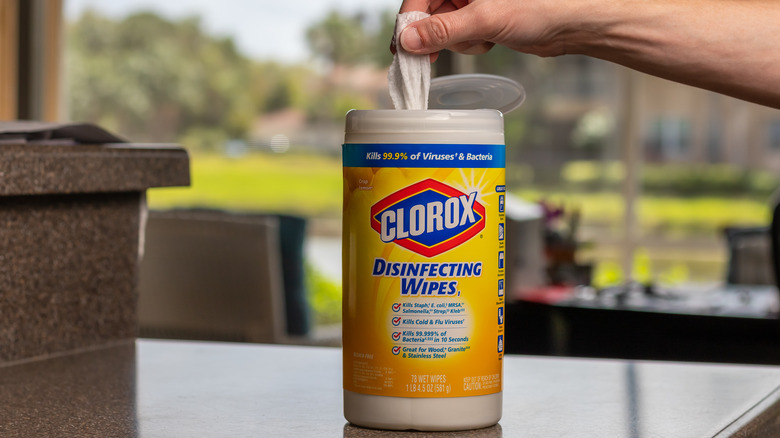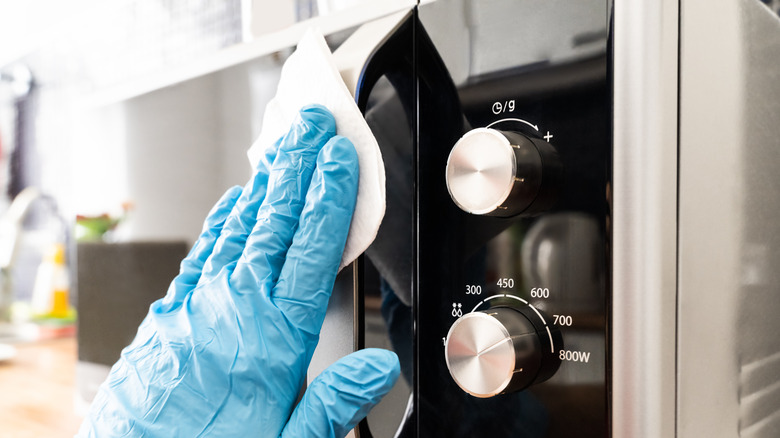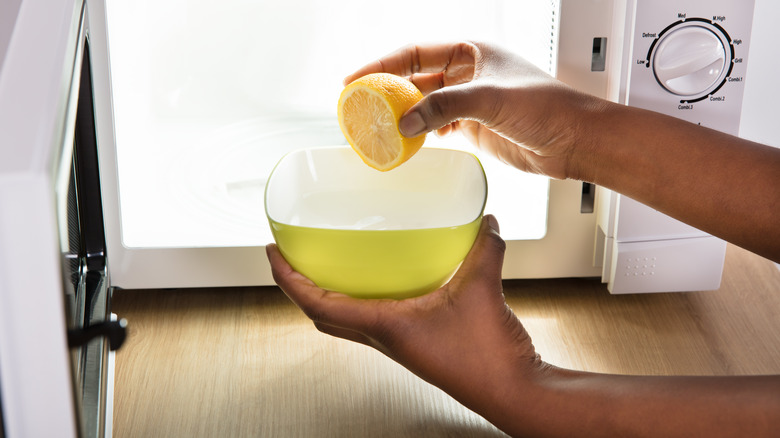What To Consider Before Cleaning Your Microwave With Clorox Wipes
We've all been there before; you're excited to step away from work or chores and dig into a mid-day meal, but when you open the microwave door, you can't help but utter, "Gross." Somebody — perhaps even you — has left behind a splatter surprise, and now it's up to you to fix it before you can enjoy your lunch. You can't stand to look at last week's lasagna splatters anymore, but is it okay to clean the microwave with those ever-so-convenient Clorox wipes sitting in the cabinet? In truth, cleaning the inside of the microwave with regular Clorox disinfecting wipes may not be the best idea.
Clorox wipes can leave behind a residue that isn't necessarily healthy to ingest, and using them may not be the most effective way to clean your microwave. In some cases, these disinfecting wipes could even cause damage to your appliance. Keep reading to learn more about why you may want to avoid using Clorox wipes and other chemicals inside the microwave, what you can do in a pinch, and other methods that are much better for wiping away forgotten messes.
Hold off on the Clorox
While they may be bleach-free, regular Clorox wipes still contain chemicals that you don't want to be steamed into your food every day. According to the Environmental Working Group, four active ingredients in Clorox wipes are considered moderately concerning due to their potential effects on the immune, endocrine, nervous, and reproductive systems. When used as intended, these ingredients probably won't affect your health, but when accidentally ingested on a regular basis, they could be harmful. With that being said, Clorox wipes can work in a pinch, but afterward, you should always thoroughly wipe any residue away with water and dry the inside of the microwave to avoid lingering chemicals that can be kicked up by steam.
Generally speaking, you should avoid putting harsh chemicals like bleach, ammonia, or powdered cleansers in your microwave. Not only are these horrible to ingest and inhale, but they can also be destructive to your microwave, corroding the protective paint, weakening plastic, and clogging ventilation holes. Similarly, you should avoid using abrasive sponges and scrub brushes, and stick to soft sponges, cotton rags, and microfiber cloths.
Clever ways to clean
Clorox wipes work when they're all you've got, but there are plenty of other ways to clean your microwave with barely any effort. It's best to stick to solutions that wouldn't potentially harm you if you accidentally ingested them, like citrus, vinegar, baking soda, and good old plain water. For a simple and flawless clean, fill a microwave-safe bowl with a few cups of water and add 2 to 3 tablespoons of white vinegar or apple cider vinegar. Microwave the bowl on high until the water is almost boiling. The amount of time this takes may vary, but three minutes usually does the trick. You want the vinegar and water to create steam inside the microwave which can soften the crusted-on food. Carefully remove the bowl of hot water from the microwave and wipe away food with a damp rag or paper towel.
For messes that are really caked on, you can repeat this method and add a squeeze of lemon juice to the bowl. The acid from the vinegar and lemon will help to further break down the food. For even more scrubbing power, mix baking soda and water into a paste and gently rub it onto stuck-on food to lift the mess. When finished, wipe the microwave interior with water and dry it before use.


